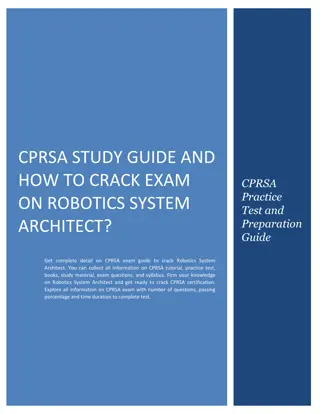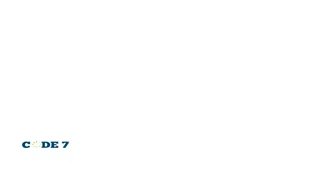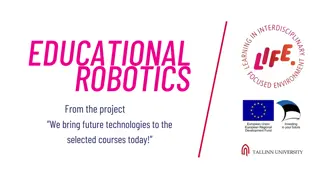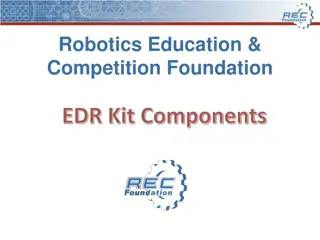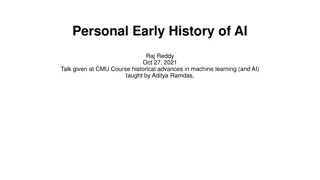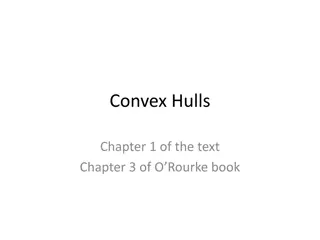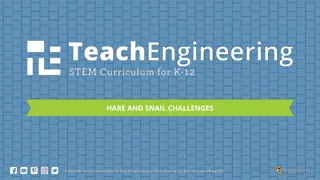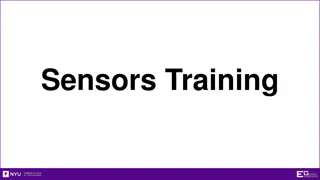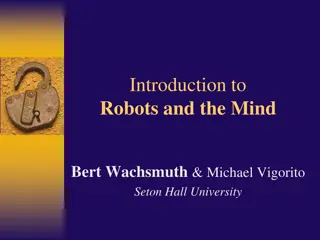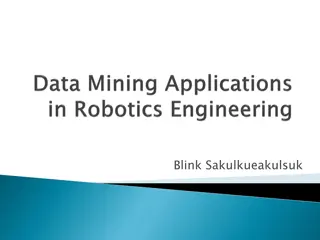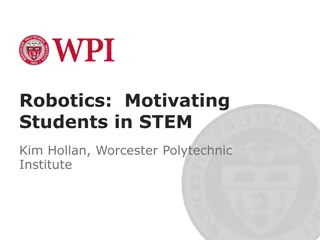History and Applications of Robotics
Explore the fascinating world of robotics through images and information on different types of robots, their capabilities, and the laws governing their behavior. Learn about the origins of robotics, the definition of a robot, and the famous Laws of Robotics proposed by Asimov. Delve into the history of robotics, starting with the first programmable robot, UNIMATE, created in 1954. Discover the diverse roles robots play, from handling dangerous tasks in nuclear power plants to performing repetitive and menial jobs. Gain insights into the evolution of robotics and the pivotal role they play in modern society.
Download Presentation

Please find below an Image/Link to download the presentation.
The content on the website is provided AS IS for your information and personal use only. It may not be sold, licensed, or shared on other websites without obtaining consent from the author.If you encounter any issues during the download, it is possible that the publisher has removed the file from their server.
You are allowed to download the files provided on this website for personal or commercial use, subject to the condition that they are used lawfully. All files are the property of their respective owners.
The content on the website is provided AS IS for your information and personal use only. It may not be sold, licensed, or shared on other websites without obtaining consent from the author.
E N D
Presentation Transcript
Robotics MSE 2400 1
What is a Robot? (1) Manipulator 3
What is a Robot? (2) Legged Robot Wheeled Robot 4
What is a Robot? (3) Autonomous Underwater Vehicle Unmanned Aerial Vehicle 5
What Can Robots Do? (1) Jobs that are dangerous for humans Decontaminating Robot Cleaning the main circulating pump housing in the nuclear power plant 6
What Can Robots Do? (2) Repetitive jobs that are boring, stressful, or labor- intensive for humans Welding Robot 7
What Can Robots Do? (3) Menial tasks that human don t want to do The SCRUBMATE Robot 8
Definition Word robot was coined by a Czech novelist Karel Capek in a 1920 play titled Rossum s Universal Robots (RUR) Robota in Czech is a word for worker or servant Karel Capek Definition of robot: A robot is a reprogrammable, multifunctional manipulator designed to move material, parts, tools or specialized devices through variable programmed motions for the performance of a variety of tasks: Robot Institute of America, 1979 9
Laws of Robots Asimov proposed three Laws of Robotics Law 1: A robot may not injure a human being or through inaction, allow a human being to come to harm Law 2: A robot must obey orders given to it by human beings, except where such orders would conflict with a higher order law Law 3: A robot must protect its own existence as long as such protection does not conflict with a higher order law 10
History of Robotics (1) The robot: UNIMATE 1954: The first programmable robot is designed by George Devol, who coins the term Universal Automation. He later shortens this to Unimation, which becomes the name of the first robot company (1962). first industrial UNIMATE originally automated the manufacture of TV picture tubes 11
History of Robotics (2) 1978: The Puma (Programmable Universal Machine Assembly) robot is developed by Unimation with a General Motors design support for PUMA 560 Manipulator 12
History of Robotics (3) 1980s: The robot industry enters a phase of rapid growth. Many institutions introduce programs and courses in robotics. Robotics courses are spread across mechanical engineering, electrical engineering, and computer science departments. 13 Barrett Technology Manipulator Adept's SCARA robots Cognex In-Sight Robot
History of Robotics (4) 1995-present: applications robotics robots drive a second growth of companies and research Emerging in small and mobile start-up 2003: NASA s Mars Exploration Rovers will launch toward Mars in search of answers about the history of water on Mars 14
Knowledgebase for Robotics Typical knowledgebase for the design and operation of robotics systems Dynamic system modeling and analysis Feedback control Sensors and signal conditioning Actuators and power electronics Hardware/computer interfacing Computer programming Disciplines: mechanical engineering, electrical engineering, computer engineering, and computer science mathematics, physics, biology, 15
Key Components Powerconversion unit Sensors Actuators Controller User interface Manipulator linkage Base 16
Robot Base: Fixed v/s Mobile Robotic manipulators used in manufacturing are examples of fixed robots. They can not move their base away from the work being done. Mobile platforms with wheels or tracks attached. Instead of wheels or tracks, some robots employ legs in order to move about. bases are typically 17
Robot Mechanism: Mechanical Elements Gear, rack, pinion, etc. Cam and Follower Inclined plane wedge Chain and sprocket Lever Slider-Crank Linkage 18
Sensors (1) Human senses: sight, sound, touch, taste, and smell provide us vital information to function and survive Robot sensors: measure robot configuration/condition and its environment and send such information to robot controller as electronic signals (e.g., arm position, presence of toxic gas) Accelerometer Using Piezoelectric Effect Robots often need information that is beyond 5 human senses (e.g., ability to: see in the dark, detect tiny amounts of invisible radiation, measure movement that is too small or fast for the human eye to see) Flexiforce Sensor 19
Sensors (2) Vision Sensor: e.g., to pick bins, perform inspection, etc. Part-Picking: Robot can handle work pieces that are randomly piled by using 3-D vision sensor. Since alignment operation, a special parts feeder, and an alignment pallete are not required, an automatic system can be constructed at low cost. In-Sight Vision Sensors 20
Sensors (3) Force Sensor: e.g., parts fitting and force feedback in robotic surgery insertion, Parts fitting and insertion: Robots can do precise fitting and insertion of machine parts by using force sensor. A robot can insert parts that have the phases after matching their phases in addition to simply inserting them. It can automate high- skill jobs. 21
Sensors (4) Example Infrared Ranging Sensor KOALA ROBOT 6 ultrasonic sonar transducers to explore wide, open areas Obstacle detection over a wide range from 15cm to 3m 16 built-in infrared proximity sensors (range 5-20cm) Infrared sensors act as a virtualbumper and allow for negotiating tight spaces 22
Sensors (5) Tilt sensors: e.g., to balance a robot Example Tilt Sensor Planar Bipedal Robot 23
Actuators (1) Common robotic actuators utilize combinations of different electro-mechanical devices Synchronous motor Stepper motor AC servo motor Brushless DC servo motor Brushed DC servo motor http://www.ab.com/motion/servo/fseries.html 24
Actuators (2) Pneumatic Cylinder Hydraulic Motor Stepper Motor DC Motor Pneumatic Motor Servo Motor 25
Controller Provide necessary intelligence to control the manipulator/mobile robot Process the sensory information and compute the control commands for the actuators to carry out specified tasks 26
Controller Hardware Storage devices: e.g., memory to store the control program and the state of the robot system obtained from the sensors 27
Industries Using Robotics Agriculture Automobile Construction Entertainment Health care: hospitals, patient-care, surgery , research, etc. Laboratories: science, engineering , etc. Law enforcement: surveillance, patrol, etc. Manufacturing Military: demining, surveillance, attack, etc. Mining, excavation, and exploration Transportation: air, ground, rail, space, etc. Utilities: gas, water, and electric Warehouses 28
What Can Robots Do? Industrial Robots Material handling Material transfer Machine unloading Spot welding Continuous arc welding Spray coating Assembly Inspection loading and/or Material Handling Manipulator Assembly Manipulator 29 Spot Welding Manipulator
Robots In Space NASA Space Station 30
Robots in Hazardous Environments HAZBOT operating in atmospheres combustible gases TROV in Antarctica operating under water containing 31
Medical Robots Robotic micro surgery assistant for 32
Robots at Home Sony Aido Sony SDR-3X Entertainment Robot 33
Future of Robots (1) Artificial Intelligence Kismet Cog 34
Future of Robots (2) Autonomy Robot Work Crews Garbage Collection Cart 35
Future of Robots (3) Humanoids HONDA Humanoid Robot 36




